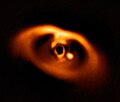This article needs to be updated.(February 2021) |
| Mission type | Space observatory |
|---|---|
| Website | soweb |
| Mission duration | 3 years nominal (proposed) [1] |
| Orbital parameters | |
| Reference system | Geocentric |
| Regime | Sun Synchronous |
| Semi-major axis | 2,000 km |
| Inclination | 105° |
| Period | 127 min |
| Main | |
| Diameter | 70 cm (28 in) [1] |
| Instruments | |
| Imaging polarimeter | |
Exoplanetary Circumstellar Environments and Disk Explorer(EXCEDE) is a proposed space telescope for NASA's Explorer program to observe circumstellar protoplanetary and debris discs and study planet formation around nearby (within 100 parsecs) stars of spectral classes M to B. [1] Had it been selected for development, it was proposed to launch in 2019.
The spacecraft concept proposed to use a 70 centimeter diameter telescope-mounted coronagraph called PIAA (Phase Induced Amplitude Apodized Coronagraph) to suppress starlight in order to be able to detect fainter radiation of circumstellar dust. [1] Characterizing constitution of such disks would provide clues for planetary formation (mostly in habitable zones), while already existing exoplanets can be detected through their interaction with dust disk. The project's Principal Investigator is Glenn Schneider. [1]



